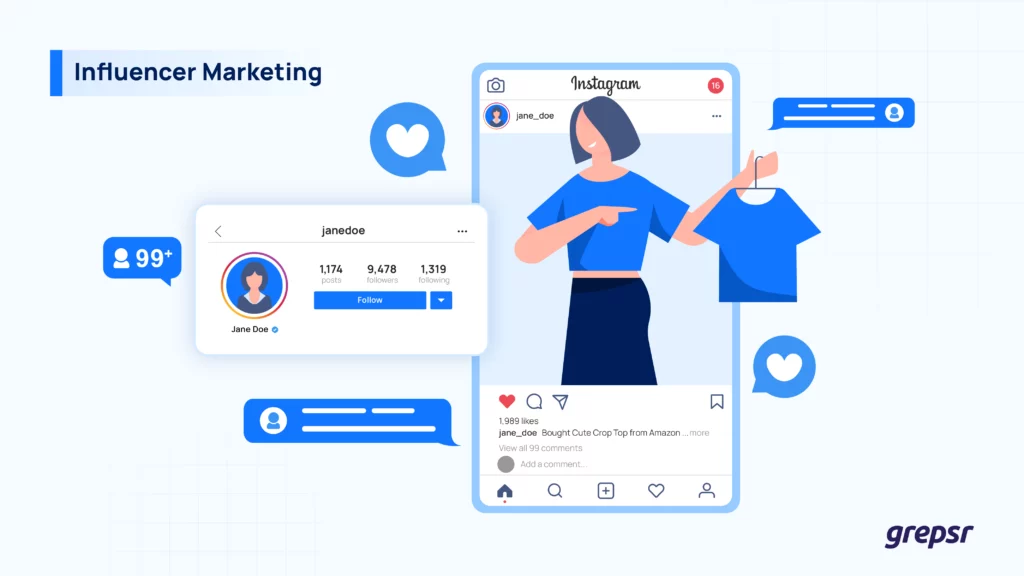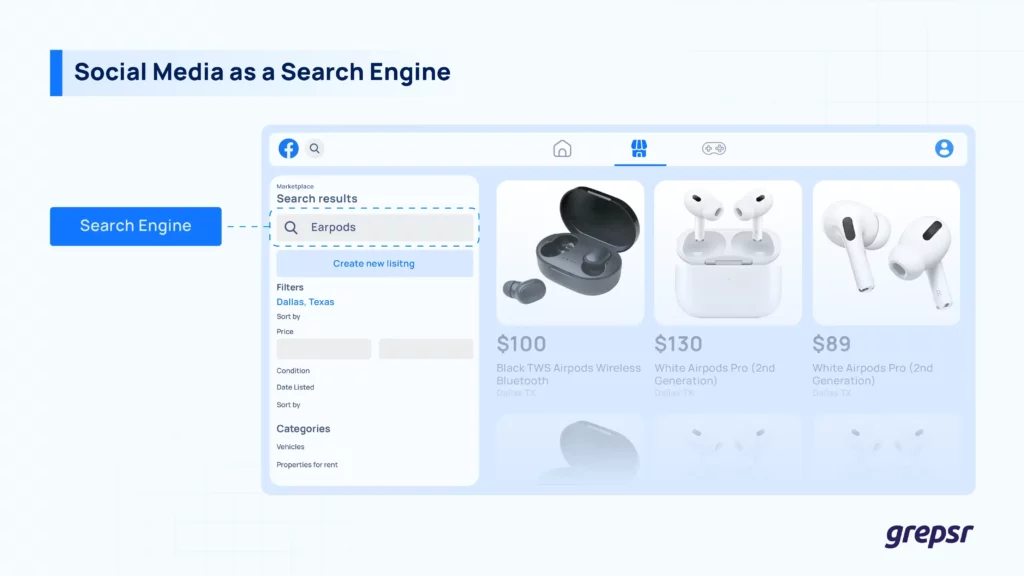
The marketing industry has come a long way from mass marketing with OOH (Out-of-home or outdoor) advertising, radio, newspaper, and television commercials to targeted digital advertisements via the internet and social media.
Today’s modern marketing is all about making the most out of Big Data.
Big Data in digital marketing reveals deeper insights by analyzing the raw data consisting of posts, unfiltered opinions, and customer engagement from social media and websites to identify marketing trends and highlights.
Let’s look into what the industry worth more than US$ 366.1 billion had on its plate in 2024 and how you can leverage insights from these trends for your marketing success in 2025.

1. AI-Driven Marketing
AI-driven strategy is critical for a marketer. In fact, it is an irresistible assistant for many marketers, 64% to be precise.
Incorporating AI helps you automate repetitive tasks like ad targeting, email campaigns, social media post-scheduling and allows you to focus on the creative strategy.
Similarly, AI-powered analytics tools help marketers forecast future trends and customer behavior to make data-driven decisions. They can predict which items will be the most sought-after, when the campaigns should be launched, and which leads are more likely to convert.
Plus, AI can break down your audience into specific segments based on behavior, preferences, demographics, and purchasing patterns. Then you can target your ads, content, email, and other marketing efforts accordingly.
2. GenAI for Content Creation

Life is easier and more efficient for marketers since the rise of free and easily accessible generative AI tools like ChatGPT, Grammarly, Dall-E, and Gemini, which produce high-quality written content, images, and videos.
Creating content takes a lot of time. Brainstorming topics, narrowing down on what’s valuable for your audience, researching the subject there’s a lot of work that needs to be done.
Marketers can now lean on GenAI tools to do all this heavy lifting. It can significantly reduce the time spent creating and editing blogs, image descriptions, social media posts, email newsletters, or landing page copy while maintaining consistent quality at scale.
3. Shoppable Social Media
Did you know that although we consider Facebook a “dead” platform with nobody regularly using it except your grandma sharing years-old memes, it is still popular because 57% of marketers rely on it?
The reason is shoppable content. It is a form of digital content, especially in social media where a customer can click through posts, images, videos, or any type of ad to make a purchase. Facebook, Instagram, and TikTok’s creator marketplace have made it easier for users to buy what they want without leaving the app. Or simply, the trend of direct shopping is boosted by Instagram and TikTok.
Research proves that 43% of Gen Z and 49% of Millennials have purchased products or services directly from social media platforms.
And because social commerce integrates with customer behaviors and browsing habits, it encourages impulse buying and streamlined purchases for businesses.
4. Short Video Content for the Win
The rise of short-form video content is what we see at every corner of the digital space. Snapchat, TikTok, and Instagram reels are what we’re used to but now, heck, even LinkedIn has a new feature that allows you to create 30 sec to 1 min short videos.
So from a business perspective, you surely understand that this trend cannot go unnoticed. Rather you have to adapt to it and do quite well at it to capture the attention of your audience and persuade them to try your service.
The reason it is so important is that it offers you the highest ROI and is used by 44% of marketers. The user engagement is off the charts at these short video platforms.
Plus, it is highly shareable and perfect for product demos, tutorials, and use-case storytelling so you must invest in it significantly to witness the impact it has on your business growth.
5. Voice Search Optimization
The process of adjusting your website and its content for users who use natural, conversational language to ask questions or voice-based searches is voice search optimization.
This is one of the rising trends as every month there are more than 1 billion voice searches. So you see that there is a big opportunity to leverage this huge traffic for your business. It helps you reach more customers, drive more traffic to your site, convert them, and increase the overall conversion rate.
For that, you must tailor SEO to conversational and natural language queries. What this means is that you should focus on optimizing based on how people ask questions in real life and not just short keywords.
Adapt your SEO efforts to target long-tail keywords that seek precise results. Not just “High-Powered Blender” but also “What is the best High-Powered Blender under $90?”.
This ensures that you appear in the voice search results for such detailed and specific phrases.
6. Rise of Influencer Marketing

Influencer marketing has been around for decades but it is only since the early 2000s that it started getting extremely popular. All because of certain individuals who became famous and gained a large following from their social media presence.
Today, it is at its peak with companies investing more in it because stats show that 33% more social media users bought products that were endorsed by influencers in 2023 than in 2022.
The new era of influencer marketing is investing in micro-influencers who have a niche set of engaging and loyal audiences of a range between 10,000 to 100,000. These prove to be more genuine and reliable for their followers than any celebrities or mega influencers with millions of inactive followers.
If you reach out to a micro-influencer who actually believes in your brand and truly wants to share/recommend it to their followers. Then, the promotions will seem more organic. It will also strengthen your brand-influencer collaboration if you develop a long-term partnership. It is more effective over one-off promotional posts that are forced and seem insincere.
7. User-Generated Content
Any form of content say images, videos, reviews, or posts created by users (excluding business accounts) is UGC.
Consumers are the pillars of UGC who share their experience regarding a product or service with honesty and reliability that help other users make informed decisions.
Most of these candid opinions are expressed in review platforms like Reddit, Quora, G2, Capterra, Tripadvisor, Google reviews, etc.
UGC enables real customers to share real experiences with a brand that resonates with other potential customers. And because people trust consumers more than brands, genuinely positive reviews drive more purchase decisions than ads.
You can collect user-generated data or candid customer reviews to measure the overall consumer sentiment towards your brand. With the insights from data analysis, you then take the necessary actions to improve whatever it is you must be improving like customer service, product variety, quality, etc.
8. Social Media as a Search Engine

Amongst the younger generation, social media hasn’t only been a place to post and share content. It is also their new search engine.
Data shows that 46% of Gen Z and 35% of millennials are likely to use social media to search for products, services, trends and even answers to common queries. But especially for product recommendations, tutorials, and reviews. All because they prefer visual content and value influencer, & community opinions to base their purchase decisions.
Instagram and TikTok are the best platforms designed for quick visual content discovery with hastings, challenges, and other trending keywords. That is what pulls the younger generation towards this style of content. Also, the easiness of exploring new trends, fashion, and products via viral user-generated content.
Thus, you should optimize your brand’s social media profiles with the same effort you make for search engine pages. Jump on the trend before it gets stale, keep optimizing with hot keywords, and update your product description with relevant tags so users can discover it without any problems.
9. Hyper-Personalization
Research conducted by HubSpot found that 96% of marketers felt that offering a personalized customer experience directly impacts increasing sales. However, this is a great struggle for most marketers.
The information that they have on their target audience is not adequate for data-driven decision-making. That’s when external data providers come in handy. They provide actionable data from the web that you can analyze to understand your customers better.
With the use of real-time data, AI, and advanced analytics, you can deliver hyper-personalized experiences to customers.
AI integration analyzes customer data to deliver personalized recommendations in real time like Netflix and Amazon. Suggest items based on their browsing history, purchases, more clicks, spent time, and ensure that each customer gets relevant options.
Additionally, data helps businesses create targeted ads and email campaigns that are curated for specific individuals. These tailored efforts that align with their activity and preferences leads to more meaningful interactions and higher conversion rates.
10. Sustainability
These days, being eco-friendly and sustainable is all the rage for both consumers and brands. Modern consumers millennials and Gen Z everywhere are growing more conscious about the environment trying to “go green”.
But remember, this is not just some new trend in 2024 that seems cool. Instead, you should adapt it as a vital part of your brand identity.
Like how IKEA is the beacon of sustainability in the business world, you should also communicate your company’s sustainable practices. Always be transparent about sourcing ethically, reducing waste, and using renewable energy.
Conclusion
The bottom line is that staying ahead of the digital marketing trends in 2024 requires leveraging AI-driven strategies.
For that, you can calmly rely on Grepsr for real-time access to data at scale. We assure your marketing efforts are backed by the most accurate of insights that will help you convert your target audiences.
Additionally, if you’re building an AI or machine learning model yourself, Grepsr can even supply the large volume, high-quality, and structured training datasets needed to optimize your algorithms.
Fuel your marketing success with Grepsr – your go-to for scalable, data-driven solutions.









































